6.04.2019
The Crater Search Operation
(Pre-SCI): CRA1
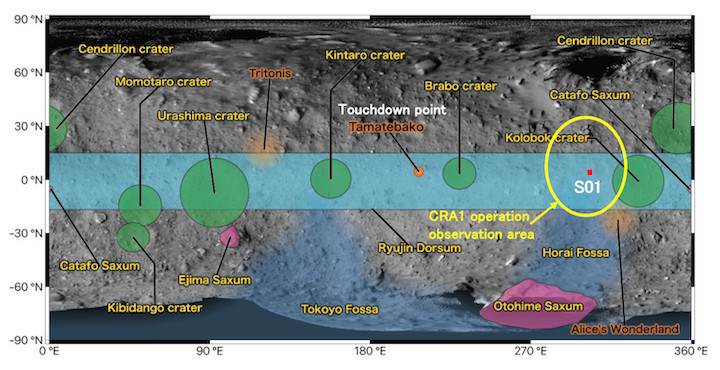
Figure 1: Area to observe during the CRA1 operation (image credit: JAXA).
Currently, we have scheduled the small carry-on impactor operation (SCI operation) for the first week in April. The purpose of the SCI operation is to create a crater on the surface of Ryugu, and it is important to be able to compare the asteroid surface before and after the SCI operation. Before performing the SCI operation, we therefore decided to observe the area where the crater is likely to be generated. This is the “Crater Search Operation (Pre-SCI)” (CRA1). The same observational procedure will be performed after the SCI operation and denoted “Crater Search Operation (Post SCI)” (CRA2).
The CRA1 operation will take place between March 20 – 22, 2019. Descent preparation work will start on the 20th and the descent will begin from the 21st. Observations at the lowest altitude reached (approximately 1.7km) will be from the 21st to 22nd and the spacecraft will ascend on the 22nd. Figure 1 shows the site that will be observed. This area includes the SO1 region that was observed during the Descent Observation Operation (DO-S01) conducted between March 6 – 8.
The operation schedule is known in Figure 2. Hayabusa2 begins its descent on March 21 at 08:57 JST (onboard time) with a speed of 0.4 m/s. On the same day at around 19:17 JST, the speed will be reduced to about 0.1 m/s. The spacecraft will continue to descend and reach the lowest point (altitude approximately 1.7km) on March 22 at around 03:32 JST and continuously observe at that altitude for a while. Hayabusa2 will begin to ascend at 05:08 JST and return to the home position. Note that the times listed here are the planned values and the actual operation times may differ.

Figure 2: Schematic diagram of the CRA1 operation (image credit: JAXA).
Note: times listed here may differ from the actual operation.
+++
Revised illustrations of Hayabusa2
At the beginning of the Hayabusa2 Project, realistic illustrations were drawn by Akihiro Ikeshita. These illustrations have now been revised to match the actual asteroid Ryugu. These illustrations show our arrival at Ryugu and the first touchdown.
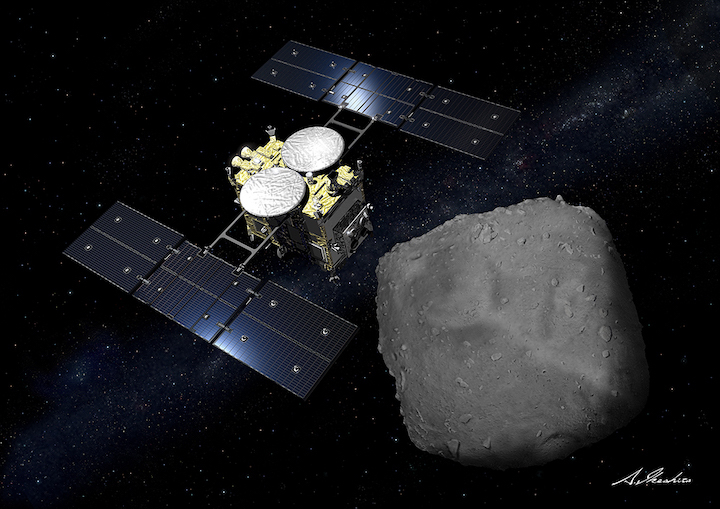
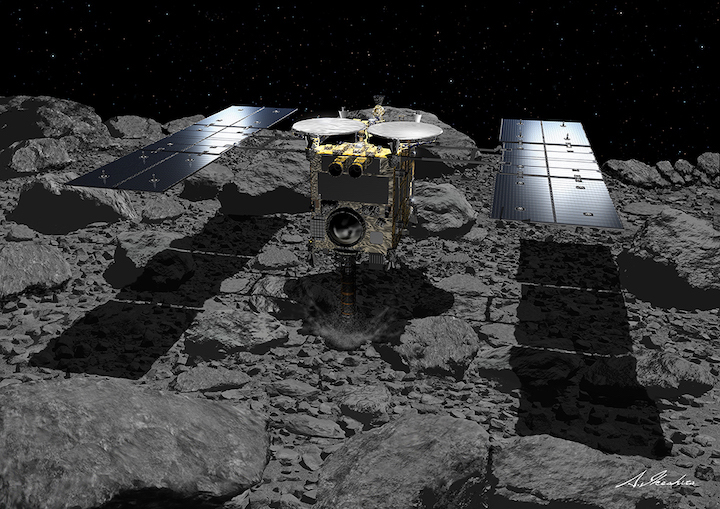
SCI (Small Carry-on Impactor)
Operation Schedule
The Small Carry-on Impactor (SCI) operation will take place between April 3 – 6. This is an impact experiment to create an artificial crater in a designated area. Please see the table and figure below for information regarding the operation schedule.
SCI operation main schedule
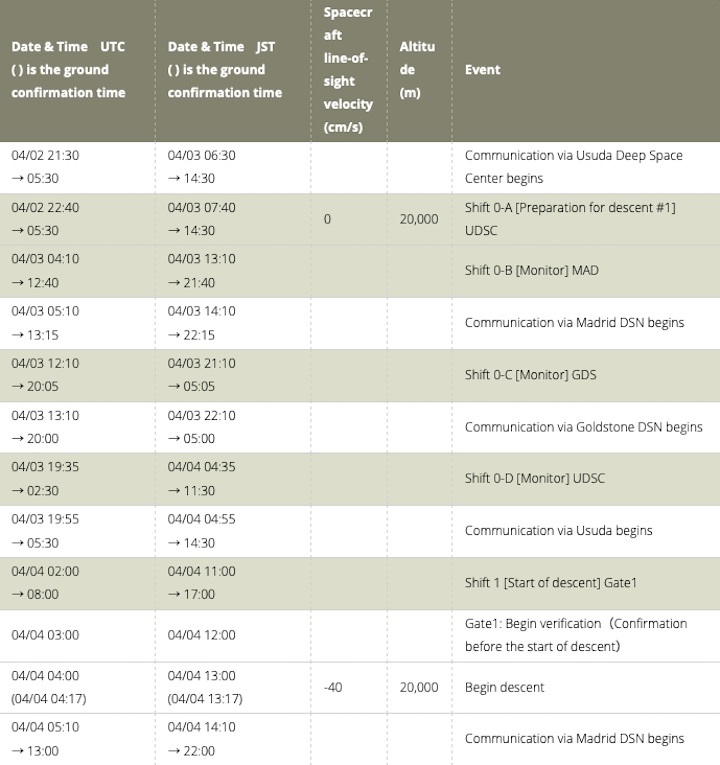
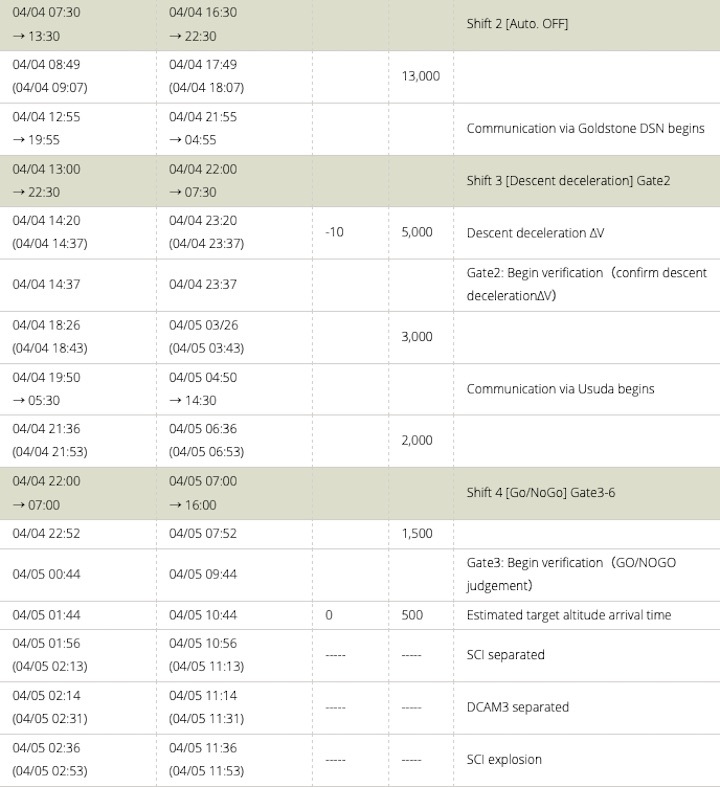
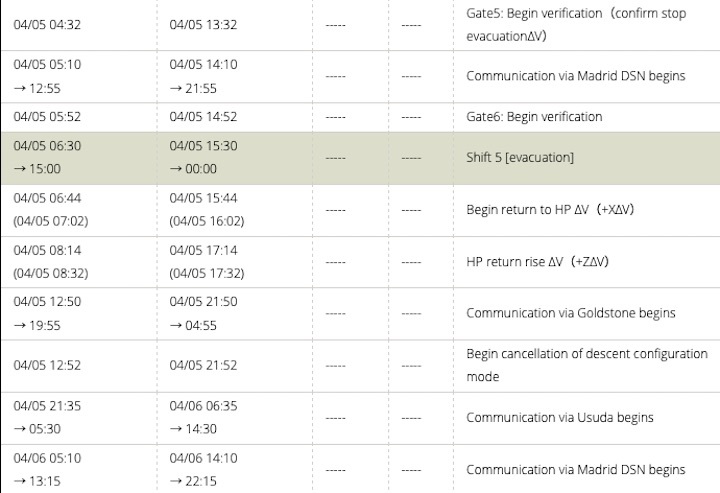
Notes:
- Time: Approximate scheduled time. UTC is Universal Time, JST is Japan standard time. There is a possibility that this may change during operation.
- Spacecraft line-of-sight velocity: This is the speed along the line-of-sight relative to the asteroid (minus is towards the asteroid, positive is away). Numerical value is displayed only when speed control is performed. After a speed control operation, the speed changes due to the gravitational force of Ryugu and other celestial bodies.
- Altitude: Approximate distance from the surface of Ryugu
- Since the spacecraft line-of-sight velocity and altitude become complicated after the SCI separation, they were omitted here.
Schematic of the SCI operation
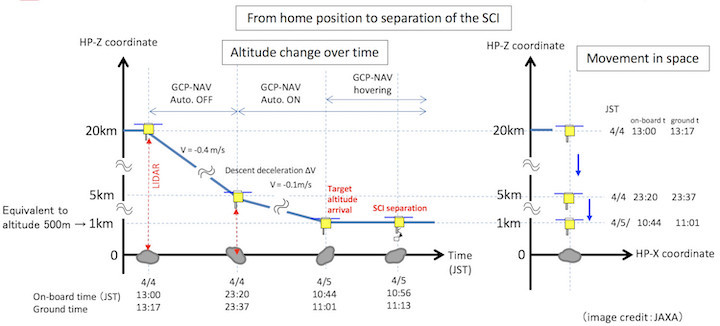
Figure 1: Schematic diagram of the SCI operation part #1. The operation from the home position to SCI separation is shown here. The graph on the left shows the change in the spacecraft position with time. On the right, the spacecraft position is shown in the x-z coordinate system (home position coordinate system). The times listed are the scheduled time and may differ from actual operations. (Image credit: JAXA.)
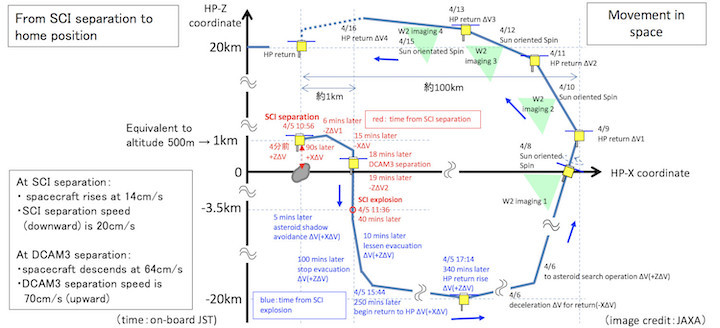
- Figure 2: Schematic diagram of the SCI operation part #2. The operation from SCI separation to the return to the home position is shown. In this figure, the position of the spacecraft in the x-z coordinate system is shown schematically. The time is the scheduled time and may differ from actual operations. (Image credit: JAXA.)
Crater generation area
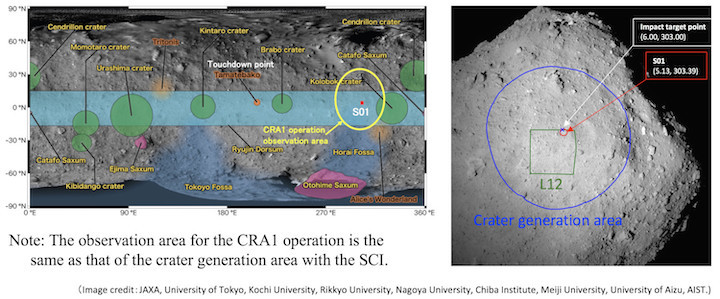
Figure 3: Area selected for creating the artificial crater during the SCI operation. The yellow ellipse in the left figure described as the “CRA1 operation observation area” roughly corresponds to the crater generation area (blue circle in the right figure). (Image credit: JAXA, University of Tokyo, Kochi University, Rikkyo University, Nagoya University, Chiba Institute of Technology, Meiji University, University of Aizu, AIST.)
+++
Navigation Images from the SCI
operation
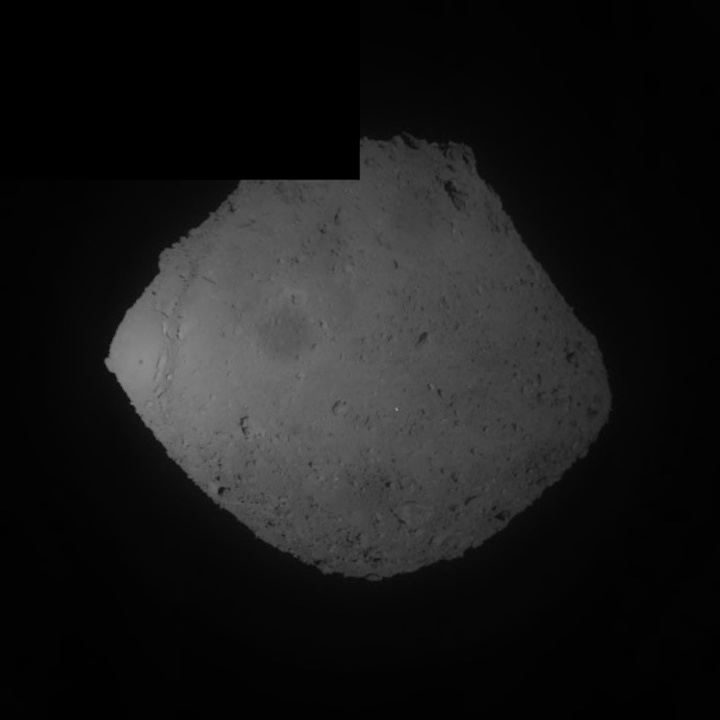
+++
Operational Status of Asteroid Explorer Hayabusa2's SCI
National Research and Development Agency
Japan Aerospace Exploration Agency (JAXA)

An image of separated SCI taken with the Optical Navigation Camera - Wide angle (ONC-W1) on April 5, 2019 at an onboard time of around 10:56 JST
Photographed from approximately 500 meters above Ryugu
Image credit: JAXA, The University of Tokyo, Kochi University, Rikkyo University, Nagoya University, Chiba Institute of Technology, Meiji University, The University of Aizu, AIST
The National Research and Development Agency Japan Aerospace Exploration Agency (JAXA) has carried out operations to separate the SCI (Small Carry-on Impactor) onboard the asteroid explorer Hayabusa2 for deployment to the asteroid Ryugu.
The SCI separation has been confirmed using Hayabusa2’s Optical Navigation Camera-Wide (ONC-W1), it is our assessment that separation of the SCI went as planned.
In order to avoid the impact given by the operation of the small carry-on impactor (SCI), Hayabusa2 was moved to the safety zone on the backside of the asteroid before the SCI began to be operated. Hayabusa2 is operating normally.
We will be providing further information once we have confirmed whether the SCI is operating and whether a crater has been created on Ryugu.
+++
Asteroid Explorer Hayabusa2’s SCI Put into Operation
April 5, 2019 (JST)
National Research and Development Agency
Japan Aerospace Exploration Agency (JAXA)
The National Research and Development Agency Japan Aerospace Exploration Agency (JAXA) separated the SCI (Small Carry-on Impactor) onboard the asteroid explorer Hayabusa2 for deployment to Ryugu and put the SCI into operation.
After the start of the operation, the camera (DCAM3) separated from Hayabusa2 captured an image that shows ejection from Ryugu’s surface, which implies that the SCI had functioned as planned.
Hayabusa2 is operating normally. We will be providing further information once we have confirmed whether a crater has been created on Ryugu.
This image captured by the camera separated from Hayabusa2 (DCAM3) shows ejection from Ryugu’s surface, which was caused by the collision of the SCI against Ryugu.
Image taken at 11:36 a.m., April 5, 2019 (Indicated by the camera, Japan time)
Image credit: JAXA, Kobe University, Chiba Institute of Technology, The University of Occupational and Environmental Health, Kochi University, Aichi Toho University, The University of Aizu, and Tokyo University of Science
Quelle: JAXA
----
Update: 7.04.2019
.
How Hayabusa2 made history with man-made crater attempt on asteroid

Yuichi Tsuda, who leads the Hayabusa2 project at the Japan Aerospace Exploration Agency, speaks at a press conference in Sagamihara, Kanagawa Prefecture, on Friday.
Space explorer Hayabusa2’s successful operation on Friday to create a crater by striking the asteroid Ryugu with a lump of copper, when confirmed, will mark the first such achievement in the world.
The mission is considered to be one of the most difficult for the probe to accomplish.
The Japan Aerospace Exploration Agency (JAXA) designed a new impactor specifically for Hayabusa2 to shoot the copper lump at the asteroid, demonstrating the high technology Japan has developed for space exploration.
Going beyond Hayabusa
“We successfully established new means of space exploration,” said Yuichi Tsuda, JAXA’s Hayabusa2 project leader, at a press conference on Friday evening, stressing the significance of the latest achievement which built on the foundations laid down by its predecessor, the original Hayabusa.
The first Hayabusa probe landed on the asteroid Itokawa in 2005. Hayabusa2, which was built using the same basic design, shares its purpose of bringing back samples of rocks, among other materials, from asteroids to Earth.
But if Hayabusa2 was just a rehash, it would be hard to gain public support for injecting a total of about ¥29 billion (about $260 million) from the state’s coffers into the project.
Taking this into consideration, Hayabusa2 was additionally given the unprecedented task of using an impactor to create a crater on an asteroid’s surface to enable it to collect samples from the asteroid’s interior that have not deteriorated or been affected by such factors as sunlight.
The conical small carry-on impactor with a diameter of about 30 centimeters works by ejecting a copper plate attached to its base. The impactor ejects the copper plate, which is about five millimeters thick and weighs about two kilograms, using explosive power to accelerate its speed to two kilometers per second and strike it against the asteroid’s surface. As the impactor was built specifically for this task, an explosives manufacturer took part in its development.
Aiming and firing the impactor at a point on the asteroid’s surface required meticulous accuracy. It was “like shooting an arrow on horseback while blindfolded,” according to a person close to the project.
From analysis of images taken by an observation camera, it is likely that the impactor operated as planned, and it is thought a crater was created on the asteroid’s surface as a result.
The U.S. National Aeronautics and Space Administration has in the past struck a comet with a lump of metal, but Friday’s attempt is the first such achievement on an asteroid.
“The significance of Hayabusa2’s exploration has grown greater. The rest of the world will look to emulate this achievement,” said Junya Terazono, associate professor at the University of Aizu.
A space odyssey
One major struggle for the project team scientists in the latest mission was how to protect Hayabusa2’s body from debris from the explosion to catapult the copper lump, as well as fragments ricocheting from the asteroid.
Hayabusa2 is located about 310 million kilometers from Earth, and it takes about 17 minutes for a signal to reach it, or vice versa, making it impossible to send commands instantaneously.
For that reason, the team decided to carry out the mission using an automatically controlled system. The complicated movement, in which Hayabusa2 evacuates while changing its direction a number of times between horizontal and vertical after releasing the impactor and an observation camera, was all programmed into the system in advance.
In February, Hayabusa2 touched down precisely on the planned landing site, which is 6 meters in diameter, on Ryugu.
The team members were able to draw from this experience an understanding of the tendencies of each of 12 altitude-controlling reaction wheels installed on Hayabusa2, building up their confidence in probe-control technology.
Stressing that they learned from the touchdown experience, Takashi Kubota, a member of the team, said, “With the technology that enables the probe to move freely, it can expand the possibilities of exploration in outer space.”
Careful consideration
Hayabusa2 will take about two weeks to return to its home position at a 20-kilometer altitude from Ryugu. Then after that, from April 22 or later, it will descend to the asteroid to confirm whether a crater has been formed on the surface. At some time as early as May, it will again land on the crater or its vicinity on the asteroid to start collecting samples of fragments.
But whatever happens next, the team believes Hayabusa2 has already managed to collect enough samples from its first landing on the asteroid in February.
It will also be able to gain scientific findings by observing the vicinity of the crater from above. A senior JAXA scientist said, “If there’s a risk that the body of Hayabusa2 may get damage by landing on the asteroid again, it will not be necessary for us to press ahead with it.”
JAXA will weigh up the pros and cons of landing the probe again after carefully assessing the safety of doing so.
Quelle: The Japan News
----
Update: 25.04.2019
.
Japan creates first artificial crater on asteroid

Japanese scientists have succeeded in creating what they called the first-ever artificial crater on an asteroid, a step towards shedding light on how the solar system evolved, the country's space agency said Thursday.
The announcement comes after the Hayabusa2 probe fired an explosive device at the Ryugu asteroid early this month to blast a crater in the surface and scoop up material, aiming to reveal more about the origins of life on Earth.
Yuichi Tsuda, Hayabusa2 project manager at the Japanese space agency (JAXA), told reporters they confirmed the crater from images captured by the probe located 1,700 metres (5,500 feet) from the asteroid's surface.
"Creating an artificial crater with an impactor and observing it in detail afterwards is a world-first attempt," Tsuda said.
"This is a big success."
NASA's Deep Impact probe succeeded in creating an artificial crater on a comet in 2005, but only for observation purposes.
Masahiko Arakawa, a Kobe University professor involved in the project, said it was "the best day of his life".
"We can see such a big hole a lot more clearly than expected," he said, adding the images showed a crater 10 metres in diameter.
JAXA scientists had previously predicted that the crater could be as large as 10 metres in diameter if the surface was sandy, or three metres if rocky.
"The surface is filled with boulders but yet we created a crater this big. This could mean there's a scientific mechanism we don't know or something special about Ryugu's materials," the professor said.
The aim of blasting the crater on Ryugu is to throw up "fresh" material from under the asteroid's surface that could shed light on the early stages of the solar system.
The asteroid is thought to contain relatively large amounts of organic matter and water from some 4.6 billion years ago when the solar system was born.
In February, Hayabusa2 touched down briefly on Ryugu and fired a bullet into the surface to puff up dust for collection, before blasting back to its holding position.
The mission, with a price tag of around 30 billion yen ($270 million), was launched in December 2014 and is scheduled to return to Earth with its samples in 2020.
Photos of Ryugu -- which means "Dragon Palace" in Japanese and refers to a castle at the bottom of the ocean in an ancient Japanese tale -- show the asteroid has a rough surface full of boulders.
Quelle: afp
+++
Japan succeeds in creating world's 1st man-made crater on asteroid
TOKYO (Kyodo) -- Japan's Hayabusa2 space probe has successfully created a man-made crater on an asteroid that altered the body's terrain in a historical first, the country's space agency said Thursday.
Hayabusa2 had shot a projectile at the Ryugu asteroid around 340 million kilometers from Earth as part of the probe's mission to explore the origin of life and the evolution of the solar system.
"The asteroid's terrain has clearly been altered," said Yuichi Tsuda, an associate professor at the Japan Aerospace Exploration Agency.
Hayabusa2, which began its descent toward the asteroid Wednesday afternoon, captured images of its surface to determine the existence of the crater after it successfully shot a metal projectile at Ryugu on April 5 in an experiment deemed the first of its kind.
According to the JAXA, the probe photographed the area hit by the projectile from a distance of 1.7 km. The agency compared images of the asteroid's surface before and after the shooting of the projectile to determine the presence of a man-made crater.
Hayabusa2 shot a copper "impact head" at Ryugu. The agency confirmed a burst of debris caused by the collision.
Launched in December 2014 from the Tanegashima Space Center in southwestern Japan, Hayabusa2 reached Ryugu last June.
It touched down in February to collect surface samples and found hydrated minerals that will help scientists determine whether asteroids brought water to Earth as hypothesized.
Hayabusa2 is due to return to Earth in 2020, according to JAXA.
Asteroids like Ryugu are often likened to fossils holding the preserved traces of the time when the solar system was born. But the effects of the solar wind have weathered Ryugu's surface, making it necessary to dig deep to collect such materials.
Quelle: The Mainichi
----
Update: 27.04.2019
.
JAXA confirms Hayabusa 2 blasted crater on asteroid Ryug
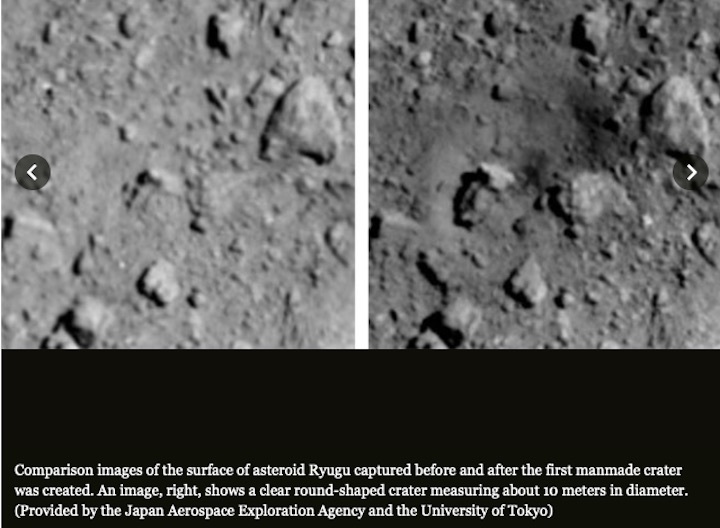
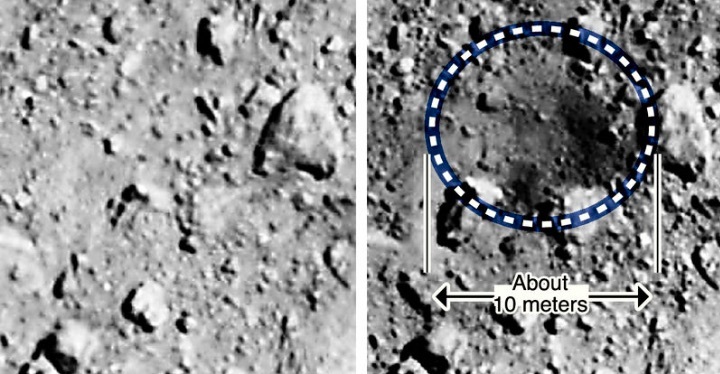
Japan's space agency confirmed on April 25 that its Hayabusa 2 space probe successfully created a crater on the surface of Ryugu after firing a metal projectile earlier in the month, the first-ever manmade crater on an asteroid.
“It was a great success, making such a clear crater,” said Japan Aerospace Exploration Agency project manager Yuichi Tsuda. “I’m so delighted I’m jumping for joy.”
The unmanned spacecraft created the crater near the asteroid’s equator by firing a 2-kilogram copper mass into the asteroid at high speed from a “small carry-on impactor” device that separated from the probe above Ryugu.
An explosive inside the device was set off to fire the copper mass at the surface of the asteroid, about 300 million kilometers from Earth.
The round-shaped crater was confirmed to be estimated about 10 meters in diameter by comparing images of the asteroid surface captured by the Hayabusa 2 probe before and after the impact, taken 1.7 km above the surface.
The latest image shows clear dents and traces from which rocks and gravel were flung from the distant “spinning top” asteroid following the impact.
The depth of the crater remains unknown at this time.
Water and organic matter dating back some 4.6 billion years ago, around the time the solar system was formed, are believed to remain in a pristine state inside the rocks beneath the surface of Ryugu.
The probe will land on the rocky asteroid to collect samples of sand, gravel and stones inside the crater as early as late May.
If the probe succeeds in its mission, it could lead to unlocking the mystery of how the solar system was formed as well as where water on Earth originated.
Quelle: The Asahi Shimbun
----
Update: 28.04.2019
.
Successful Operation of Asteroid Explorer Hayabusa2's SCI
National Research and Development Agency
Japan Aerospace Exploration Agency (JAXA)
Japan Aerospace Exploration Agency (JAXA) separated the SCI (Small Carry-on Impactor), which had been onboard the asteroid explorer Hayabusa2, on April 5, 2019, for deployment to Ryugu, and then put the SCI into operation.
As a result of checking the images captured by the Optical Navigation Camera - Telescopic (ONC-T) onboard the asteroid explorer Hayabusa2, we have concluded that a crater was created by the SCI.
Hayabusa2 is operating normally.
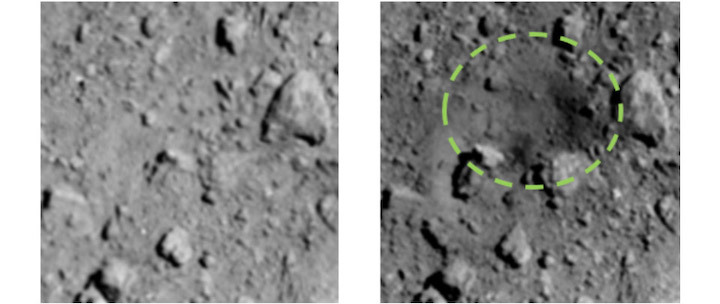
Quelle: JAXA
----
Update: 10.05.2019
.
JAXA finds 10 more artificial craters made on Ryugu asteroid by Japan's Hayabusa2 probe
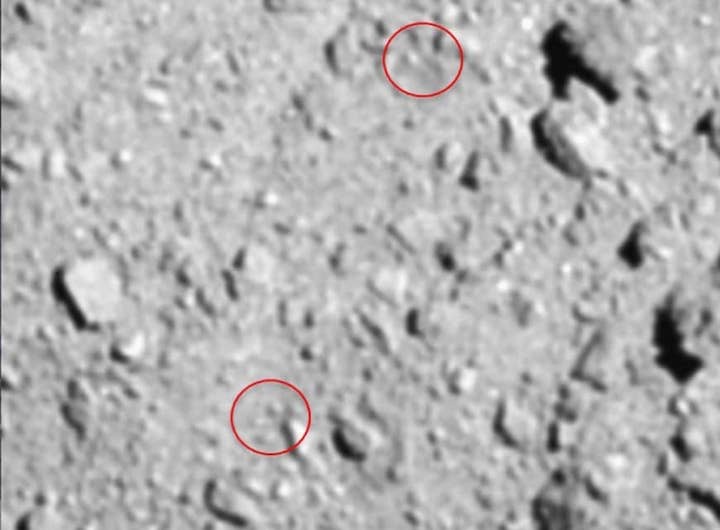
Red circles show changes in landforms, including craters, on the Ryugu asteroid that were produced with projectiles released from Japanese space probe Hayabusa2. | JAXA / VIA KYODO
The Japan Aerospace Exploration Agency said Thursday that 10 smaller, man-made craters had been found on an asteroid in addition to the larger crater its Hayabusa2 space probe produced last month as part of its mission to gain insight into the origin of life and the evolution of the solar system.
When the asteroid explorer fired a metal object at the Ryugu asteroid on April 5 to create a crater in a world first, scattered fragments of the impactor made other craters, about 1 meter in diameter each, JAXA said.
The newly discovered craters along with the initial one found earlier — which is about 10 meters in diameter and 2 to 3 meters in depth — are expected to help the agency examine the surface of the asteroid and estimate its age, according to JAXA.
The agency will continue to investigate the surface of Ryugu, around 340 million kilometers from Earth, in the hope that by June it will have found a suitable site for Hayabusa2 to collect more surface samples following the first such procedure in February.
Launched in December 2014 from the Tanegashima Space Center in Kagoshima Prefecture, Hayabusa2 reached Ryugu last June and is scheduled to return to Earth around the end of 2020 after completing its mission.
Quelle: The Japan Times
+++
Artificial crater on Ryugu has diameter over 10m
Japan's space agency says an artificial crater on the asteroid Ryugu has a diameter of more than 10 meters and a depth of 2 or 3 meters.
Officials of the Japan Aerospace Exploration Agency, or JAXA, say they plan to judge by mid-June whether its Hayabusa2 space probe can land in or near the crater.
The probe made the first-ever artificial crater on an asteroid last month by using a small device called a carry-on impactor to fire a metal projectile into Ryugu's crust.
JAXA's analysis of images shot from above shows the crater's dimensions.
The agency says about 10 nearby craters with diameters of about 1 meter may have been created by fragments of the impactor.
JAXA is considering carrying out a second landing of the probe in or near the crater to collect rocks.
It plans to carry out up to three more rounds of observation of the terrain near the crater from above to see if such a landing is possible.
In the first round, scheduled for May 16, the probe would descend to an altitude of 10 meters and drop a landing target.
JAXA project manager Yuichi Tsuda says there's a need to take into account possible failure that could risk losing rocks the probe collected after its first landing.
Quelle: NHK
----
Update: 17.05.2019
.
Hayabusa2 Aborts Attempt to Drop Marker near Asteroid Crater
Japan's unmanned space probe Hayabusa2 on Thursday aborted its attempt to drop a target marker to a location near a crater it blasted open on the asteroid Ryugu.
The operation was part of the preparations for a possible landing of the Japan Aerospace Exploration Agency's probe near the artificial crater, located close to the asteroid's equator.
Hayabusa2 automatically stopped its descent toward the asteroid when it reached an altitude of about 50 meters from the surface, JAXA said.
After the halt, the probe switched to an ascent without dropping the marker, the agency said, adding that the craft is in normal condition.
Under JAXA's plan, Hayabusa2 was to descend to an altitude of about 10 meters to drop the marker.
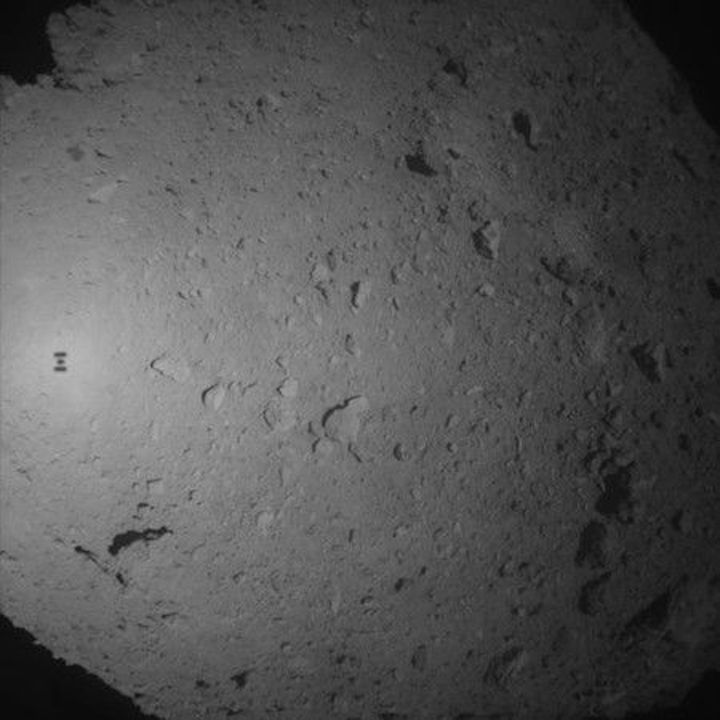
Quelle: nipponcom
